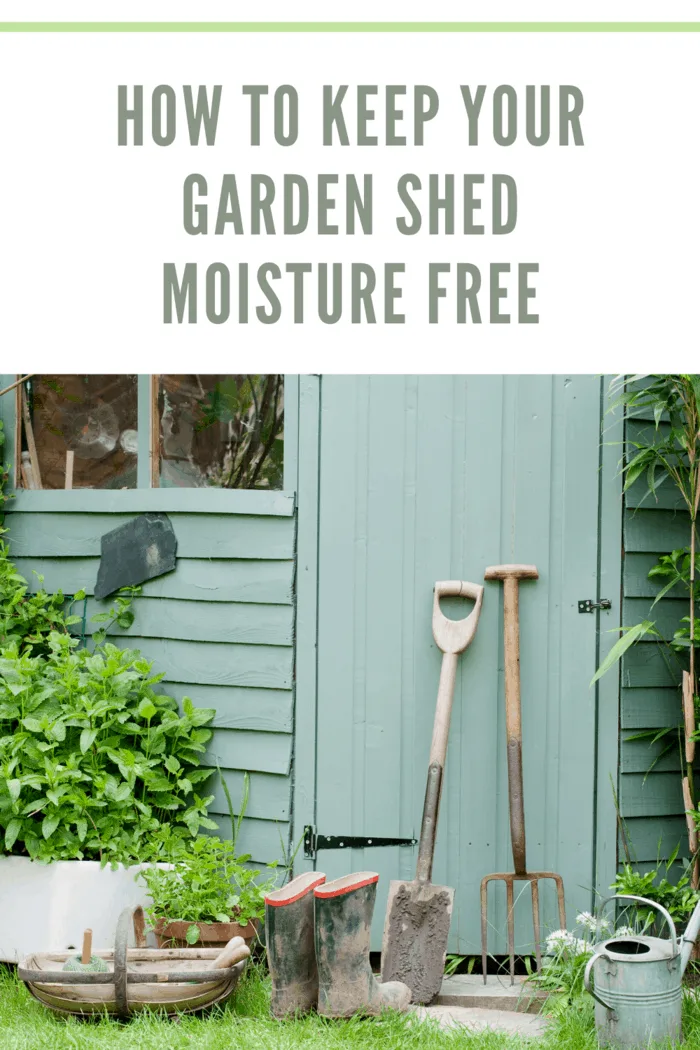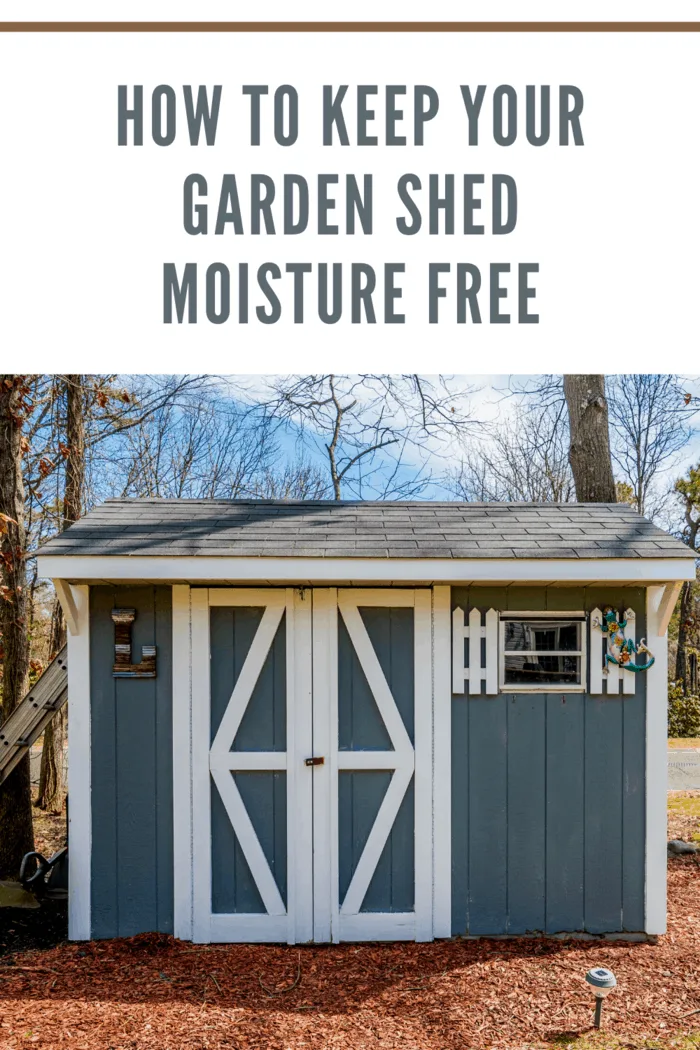One of the most common problems observed based on the garden shed is the presence of excessive moisture within the garden shed. Here’s how to keep your garden shed moisture free.
Garden sheds are indisputably convenient structures that can serve a host of purposes based on what need arises foremost within the homestead.
Despite their numerous uses, garden sheds are still, by and large, ‘delicate’ structures.
While their construction may be sturdy, with the use of robust materials, they do not always have detailed implemented measures to prevent the effects of exposure to the elements from taking their toll.
Having excess moisture build-up within your shed can result in accelerated or induced damage to the items stored within.
To prevent this, you must consider the variety of methods available to keep moisture out of the garden shed.

How to Keep Your Garden Shed Moisture Free
There are several reasons why you would want a moisture-free garden shed:
- Protection of items stored inside: A moisture-free garden shed protects items stored inside from moisture damage. Moisture can cause rust, mold, mildew, and decay, damaging tools, equipment, and other items stored in the shed.
- Improved air quality: A moisture-free garden shed also helps to improve the air quality inside the shed. Moisture in the air can lead to an increase in humidity levels, which can cause musty odors and promote the growth of mold and mildew.
- Prevents structural damage: Moisture can also cause structural damage to the shed itself. Over time, moisture can cause wood to rot, metal to rust, and other materials to deteriorate, compromising the structural integrity of the shed.
- Reduces pest infestations: Moisture can attract pests, such as termites and carpenter ants, which can cause further damage to the shed and items stored inside.
Overall, a moisture-free garden shed is essential to protect the items inside, improve air quality, prevent structural damage, and reduce pest infestations.
Select an appropriate foundation.
The best foundation for a garden shed to keep it moisture-free will depend on the specific conditions of your site, the size of your shed, and your budget. However, here are some options that can help to prevent moisture from entering the shed:
- Concrete slab foundation: A concrete slab foundation is a permanent and durable solution that provides excellent moisture resistance. The concrete should be sloped away from the shed to prevent water from pooling around the foundation.
- Gravel or crushed stone foundation: A gravel or crushed stone foundation is a cost-effective option that provides good drainage and prevents water from pooling around the shed. This type of foundation is also easy to install.
- Pressure-treated wood foundation: A pressure-treated wood foundation is resistant to moisture and rot, making it a good choice for areas with high humidity or frequent rainfall. This type of foundation is also easy to install and can be less expensive than a concrete foundation.
- Raised foundation: A raised foundation, such as a pier or post-and-beam foundation, can help to keep the shed elevated above the ground and away from moisture. This type of foundation is ideal for areas with high water tables or frequent flooding.
It’s important to note that regardless of the type of foundation you choose, proper site preparation and drainage are essential to keep the shed moisture-free. Grading the site to ensure proper drainage and installing gutters and downspouts can also help to prevent water from entering the shed.
Ensure adequate venting.
Proper ventilation is essential for keeping a garden shed moisture-free.
Here are some ways to ensure adequate venting:
- Windows: Installing windows in the shed can help to promote air circulation and allow for natural ventilation. Windows can be placed on opposite sides of the shed to create cross-ventilation.
- Vents: Installing vents in the roof or walls of the shed can also help to promote air circulation and prevent moisture buildup. Vents can be made of metal, plastic, or wood, and come in a variety of shapes and sizes.
- Ridge vent: A ridge vent is a type of vent that runs along the peak of the roof. It allows hot air to escape from the shed and promotes air circulation. Ridge vents are effective for larger sheds or those located in areas with high humidity.
- Soffit vents: Soffit vents are installed in the eaves of the shed and allow air to enter the shed from the bottom. This creates a flow of air that circulates throughout the shed, preventing moisture buildup.
- Gable vents: Gable vents are installed in the gable ends of the shed and allow hot air to escape from the shed. They are effective for sheds with a peaked roof.
It’s important to note that the size and placement of vents will depend on the size of the shed, the climate in your area, and the type of items stored in the shed. It’s recommended to consult with a professional or follow the manufacturer’s recommendations for proper venting.

Adequate Sealing
Proper sealing is essential for keeping a garden shed moisture-free.
Here are some ways to ensure adequate sealing:
- Caulking: Applying caulk around the doors, windows, and any gaps in the shed can help to prevent moisture from entering. Silicone or latex caulk can be used for this purpose.
- Weatherstripping: Installing weatherstripping around the doors and windows can help to seal out moisture and prevent air leaks. Weatherstripping is available in a variety of materials, including foam, rubber, and vinyl.
- Flashing: Installing flashing around the shed’s base can help prevent water from seeping in through the bottom. Flashing is typically made of metal and is installed at the joint between the shed and the foundation.
- Sealing tape: Applying sealing tape to the shed’s seams and joints can help create a watertight seal. Sealing tape is typically made of rubber or foam and can be applied to the inside or outside of the shed.
- Door sweeps: Installing a door sweep on the bottom of the shed door can help to seal out moisture and prevent drafts. Door sweeps are typically made of rubber or vinyl and can be attached to the bottom of the door with screws or adhesive.
It’s important to note that proper sealing should be done in conjunction with proper venting to ensure adequate air circulation. This will help to prevent moisture buildup and maintain a moisture-free environment inside the shed.
Make Use of Desiccants
Desiccants are materials that absorb moisture from the surrounding air.
There is a large variety of desiccants available for use that can be applied in the elimination of moisture from the interior of your garden shed.
Desiccants can be effective in keeping a garden shed moisture-free.
Here are some ways to make use of desiccants:
- Silica gel packets: Silica gel packets are a common type of desiccant that are used to absorb moisture. These packets can be placed inside the shed to help keep the air dry. They are available in a variety of sizes and can be purchased online or at hardware stores.
- Desiccant dehumidifier: A desiccant dehumidifier is a device that uses a desiccant material, such as silica gel, to absorb moisture from the air. This type of dehumidifier is effective in areas with low temperatures and low humidity. They can be purchased online or at home appliance stores.
- Calcium chloride: Calcium chloride is a type of salt that can be used as a desiccant to absorb moisture. It can be placed in a container or a mesh bag and hung inside the shed to help keep the air dry. Calcium chloride is available at hardware stores and online.
- Charcoal: Activated charcoal can also be used as a desiccant to absorb moisture. It can be placed in a container or a mesh bag and hung inside the shed to help keep the air dry. Activated charcoal can be purchased online or at health food stores.
It’s important to note that desiccants do not substitute for proper venting and sealing. They should be used in conjunction with proper ventilation and sealing to ensure adequate air circulation and prevent moisture buildup inside the shed. It’s also important to replace desiccants regularly to ensure they absorb moisture effectively.

Maintain order.
Organizing a garden shed can help maximize storage space, make it easier to find and access tools and equipment, and keep your shed moisture-free.
Here are some steps to follow for organizing a garden shed:
- Declutter: Start by removing everything from the shed and sorting items into piles. Keep items in good condition that you use regularly, and discard or donate items that are broken, damaged, or no longer needed.
- Categorize: Once you have sorted the items, categorize them into groups, such as hand tools, power tools, gardening supplies, and outdoor equipment. This will make it easier to find and access items when you need them.
- Install shelving: Install shelving units in the shed to maximize storage space. You can use freestanding shelving units or build your own shelves using wood and brackets.
- Use hooks and hangers: Use hooks and hangers to hang items on the walls of the shed, such as shovels, rakes, and hoses. This will help to free up floor space and keep items organized and easy to access.
- Label: Label containers and shelves to help identify the contents of each container and keep everything organized. This will make it easier to find items when needed and help keep the shed tidy.
- Utilize vertical space: Make use of the vertical space in the shed by installing overhead storage units or hanging baskets from the ceiling. This will help to maximize storage space and keep the floor clear.
- Keep it clean: Regularly clean the shed to prevent dust and debris buildup. This will help to maintain a clean and organized space.
By following these steps, you can organize your garden shed and create a functional and efficient space for storing tools and equipment.
Maintain the surroundings.
The corner in which you place your garden shed should be well maintained.
If you have a large garden with plants everywhere, be careful to take note of the material used to make your garden shed.
Plants retain moisture which could impact the integrity of the garden shed over time.
Metal structures may rust, while wooden ones begin to buckle and rot.
Final Thoughts:
Effective moisture elimination from your garden shed should start right from the building process.
Your contractor should be able to construct a reliable and sturdy garden shed that will serve you long after it is first put in.
If you would like to add a garden shed to your home, do not hesitate to seek only the best contractor available.
